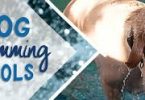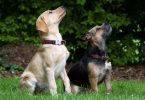 All dogs play and interact using their jaws, teeth and tongue. Called “mouthing” or “play-biting” (very different from aggressive biting), it is their instinctual programming to play with their litter mates and other dogs by jaw-wrestling and inhibited biting. Most dogs attempt to play with humans in this way as well, especially during puppyhood when the urge to use their mouth is strongest.
All dogs play and interact using their jaws, teeth and tongue. Called “mouthing” or “play-biting” (very different from aggressive biting), it is their instinctual programming to play with their litter mates and other dogs by jaw-wrestling and inhibited biting. Most dogs attempt to play with humans in this way as well, especially during puppyhood when the urge to use their mouth is strongest.
Play-biting serves an important purpose in a dog’s life. Because dogs use their mouths to interact with their world (unlike humans, who usually use their hands) it is crucial that a dog keeps this sensory organ in good shape with lots of exercise. Jaw-wrestling and inhibited biting are important parts of a dog’s social behavior, and much rehearsal is necessary for these social behaviors to become honed to the point where the dog can function properly in doggie society. Dogs mouth and play-bite throughout their entire lives to learn how hard or soft they should bite, and to keep their mouths speedy and functional. Dogs have to live with people. So for this reason it is critical for dogs to learn the appropriate use of their mouths with humans. Because dogs can bite with great force, even in play, it is crucial to get a management plan in place and clearly teach your dog what is appropriate, and what isn’t.
By starting young, you can easily teach your puppy or young adult that mouthing humans is just not acceptable. Whether it be a very young puppy incessantly chewing on hands or an older dog that grabs pant legs or shirt sleeves, it can be extremely annoying to pet owners and people who encounter the dog. Aside from the pain factor, play biting can evolve into a serious problem such as rough play, dominance or aggression. When people get puppies with a lot of prey drive they are often at a loss as to what to do to control the little alligator they live with. Below are a list of resolutions for you to try. Be sure to pick one method and stick to it. You may have to correct the dog many times before the understand. But don’t give up! Repetition and consistency are the best teacher.
Trade
The best answer is to redirect the puppy to a toy. Trade me that arm for this toy, and you’ll receive plenty of praise when your chewing is redirected to an appropriate outlet.
Yelp & Shun
Another effective method is the “Yelp and Shun” method.
Try “yelping” in a loud high-pitched voice when he bites. As soon as he lets go, turn away from him, and refuse to play any longer. This mimics the behavior that his pack-mates would use when he gets out of line. Before long, your puppy will learn that using his mouth on his people cause his people to turn away from him.
Muzzle Correction
When your puppy grabs your hand, flip it around on him and wrap it around his muzzle, holding his mouth closed for a few seconds. This is not a pleasant experience, and many dogs often get the hint fairly quickly. This method works best on puppies. It is a much more difficult correction to use on a large or adult dog.
Crate
If you cannot get the puppy to settle down, calmly place him in his crate with a chew-toy for a little siesta or time out.
If your puppy is biting/mouthing you during play or when you’re just trying to pet him, simply END the interaction, get up and leave. This will teach the dog that his biting causes you, his playmate, to go away. Ignoring the puppy means not speaking to it, looking at it or touching it in any way.
Be aware and make sure you are NOT reinforcing his biting. When he bites are you yelling at him to stop, are you lunging after him, are you shaking him by the scruff? These can be seen as attention from you so the puppy will learn that by biting you, he can get you to play and the biting will escalate.
Copyright © All That Dog






